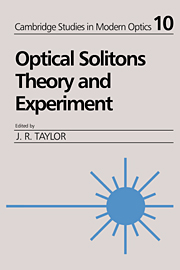Book contents
- Frontmatter
- Contents
- List of contributors
- Preface
- 1 Optical solitons in fibers: theoretical review
- 2 Solitons in optical fibers: an experimental account
- 3 All-optical long-distance soliton-based transmission systems
- 4 Non-linear propagation effects in optical fibres: numerical studies
- 5 Soliton–soliton interactions
- 6 Soliton amplification in erbium-doped fiber amplifiers and its application to soliton communication
- 7 Non-linear transformation of laser radiation and generation of Raman solitons in optical fibers
- 8 Generation and compression of femtosecond solitons in optical fibers
- 9 Optical fiber solitons in the presence of higher-order dispersion and birefringence
- 10 Dark optical solitons
- 11 Soliton-Raman effects
- Index
8 - Generation and compression of femtosecond solitons in optical fibers
Published online by Cambridge University Press: 21 October 2009
- Frontmatter
- Contents
- List of contributors
- Preface
- 1 Optical solitons in fibers: theoretical review
- 2 Solitons in optical fibers: an experimental account
- 3 All-optical long-distance soliton-based transmission systems
- 4 Non-linear propagation effects in optical fibres: numerical studies
- 5 Soliton–soliton interactions
- 6 Soliton amplification in erbium-doped fiber amplifiers and its application to soliton communication
- 7 Non-linear transformation of laser radiation and generation of Raman solitons in optical fibers
- 8 Generation and compression of femtosecond solitons in optical fibers
- 9 Optical fiber solitons in the presence of higher-order dispersion and birefringence
- 10 Dark optical solitons
- 11 Soliton-Raman effects
- Index
Summary
Introduction
The traditional methods for soliton generation in optical fibers use laser sources which generate stable transform-limited ultra-short light pulses, the pulse shape and spectrum of which coincide with those of soliton pulses in fibers. For a long time only color-center lasers satisfied these conditions, and these lasers were used in the majority of soliton experiments (see, for example, Mollenauer et al., 1980; Mollenauer and Smith, 1988). The soliton laser (Mollenauer and Stolen, 1984) is also based on a color-center laser. The successes in semiconductor laser technology has made it possible to use laser diodes in recent soliton experiments (see, for example, Iwatsuki et al., 1988).
In this chapter we shall discuss alternative methods for soliton generation in fibers. In these methods the laser radiation coupled into the fiber is not a fundamental soliton at the fiber input, but the fundamental solitons are formed from the radiation due to the non-linear and dispersive effects in the fiber. Methods for the generation of a single fundamental soliton as well as high-repetition rate (up to THz range) trains of fundamental solitons, which are practically non-interacting with each other, will be described. High-quality adiabatic fundamental soliton compression and the effect of stabilisation of the femtosecond soliton pulse width in fibers with a slowly decreasing second-order dispersion will also be discussed. We shall discuss the problem of adiabatic soliton compression up to a duration of less than 20 fs, so we shall also consider a theoretical approach for the description of ultrashort pulse (USP) propagation through the fiber.
- Type
- Chapter
- Information
- Optical SolitonsTheory and Experiment, pp. 266 - 313Publisher: Cambridge University PressPrint publication year: 1992
- 7
- Cited by



